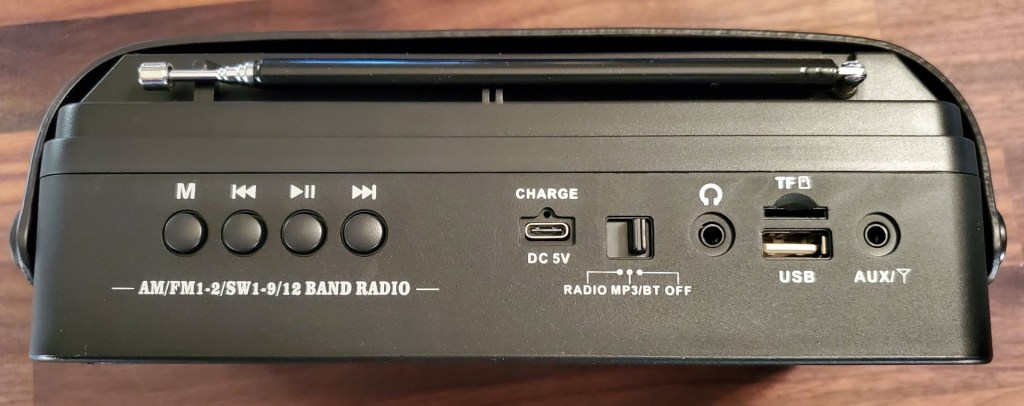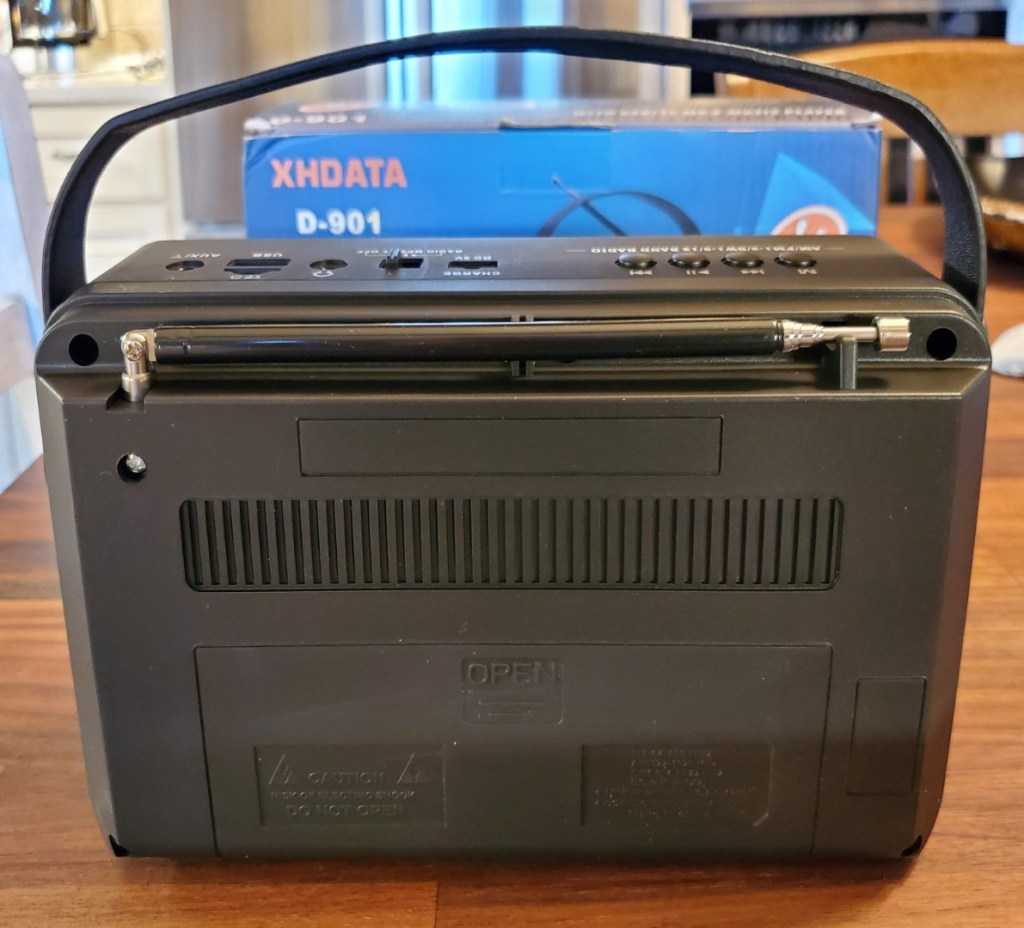XHDATA D-901 AM/FM/SW Radio With MP3 Player & Bluetooth
The XHDATA D-901 is an interesting device for several reasons. I got mine for $29.98 at Amazon:

The D-901 is a DSP-tuned analog-style portable. It covers AM from 520 – 1730 KHz, FM from 64 or 87– 108 MHz in two bands (see comment below), SW from 4750 – 22,999 KHz, analog-style tuning knob, MPs playback via Tiff card or USB stick, Bluetooth playback, Aux audio input/SW/FM antenna input, headphone jack, a flashlight with a simple slide switch for easy access and an unusually comfortable soft carrying handle. It also has a digital readout showing playback modes such as Mode, Track number, etc. It can run on a built-in USB (Type C port) rechargeable 18650 Li-ion battery or 2 conventional D cells. (See Warning Below)
There are some errors in the specifications; the specified AM band coverage is 520 – 1620 which is also imprinted on the rear of the radio but my radio’s dial goes up to 1730 KHz. The listing also says the radio has a built-in AC power supply but mine does not, although looking in the battery compartment there is an empty slot labeled AC 120 – 240 – evidently that option has been deleted, at least from the US import version…there may be other versions in other areas.

One oddity – there are two FM bands; one covering 64 – 108 MHz, the other spanning 87-108 according to the dial scales. This is an unusual way to offer different FM band limits but it works.
A few notes:
*Warning! The rechargeable 18650 Li-ion cell is connected in parallel to the D cell contacts (!!!) so NEVER USE THE USB CHARGING CABLE WHEN STANDARD D CELLS ARE IN THE RADIO! A leakage or fire danger will result. If using the 18650 battery remove the D cells. If using D cells remove the 18650 battery and DO NOT PLUG IN A USB CHARGER.
* The headphone jack is a stereo jack so stereo earbuds will play in both ears but the audio is mono on all sources.
* The Aux audio input jack does indeed double as a SW/FM external antenna input.
In Use: The D-901 offers many features at this price level but as they say, there is no free lunch. In terms of AM/FM/SW reception the sensitivity is not bad at all – in fact I was surprised that the radio did pretty well overall in terms of capturing weak signals on all bands – even weak daytime SW was surprisingly good. The problem is that the tuning behavior is not user friendly. The first issue is fairly common in DSP radios with analog-style tuning…false images. As you tune across a station there are several peaks but only one is the correct peak which gives loudest volume and clearest audio. There are several peaks for each station. As I said, this is not uncommon with DSP analog-style radios, but the D-901 adds an additional wrinkle which makes finding the true peak more frustrating…the radio grabs very aggressively to the signals it receives over a wide dial span, then it jumps to the next signal and may skip over one you want. In my area I have easily receivable daytime signals at 550, 570, 590 and 630 KHz. These are not that closely spaced and any decent radio can separate them easily. But trying to find them as I tune on the D-901 is tricky. If I start at the bottom of the dial, 550 will come in. If I slowly tune upwards the radio will usually miss 570 and jump to 590, but I have to check several peaks of 590 to get the right one. If I tune downwards, it may or may not stop at 570. It’s like some sort of AFC which fights you as you try to tune.

Case in point: The radio’s AM dial begins at 520 KHz, but with the dial at minimum it was receiving 550 (not its true peak but a weak false peak) of the lowest frequency station here in the day time. That seemed odd so I took it to the test bench and generated a signal at 520 but the radio continued to receive 550 until I tuned it up then back down again…then 520 popped in. In other words, when my radio is tuned to the bottom of the AM band it could be receiving either 520 or a false peak of 550 depending on how we got there.
In real world use this means that when looking for a specific station you may miss it as the radio overshoots, then you have to tune back down and perhaps up again to find the one you want. A digital spotter radio makes finding specific frequencies much easier but this is not a fun radio to tune around with. And some stations (570 in my case) almost never can be found even though it is a stronger signal than 550. This drives me nuts because as I said the actual sensitivity on all the bands is not bad…it is only hampered by the excessive and moving false images.
Two other issues: I also find the AM audio a bit muffled for my tastes…certainly more muffled than needed given this level of selectivity. Sound is not bad on MP3, Bluetooth or FM however. Also, my particular unit seems finicky about the Tiff cards it will play. I have several of these…they all happen to be 32 Gb cards loaded with music and old-time radio shows, but one of them just ill not play in the D-901 although it plays normally on every other mp3 player I have tried. This may very well be a fluke that will not affect anyone else…I just have to report that it happened to me and is a quirk I have not seen before. I will say that the flashlight is nice because its dedicated slide switch makes it so easy to use…no menus needed to get to it.


Conclusion: I wish I could have been more positive about the XHDATA D-901. It is advertised as a radio “for elders”, which is a nod to the large tuning knob and analog-style function. But the reality is considerably less favorable for anyone who enjoys tuning an analog radio…the XHDATA D-901 is tricky at best, frustrating at worst. To be sure, for $30 it’s feature set is good and its actual reception is good but getting it properly tuned to a station is not easy.
Conditionally Recommended
I found this interesting information about XHDATA:.
“XHDATA was established in 2015, X stands for infinite, H stands for happy, DATA stands for data, “XHDATA” means infinite storage of happy moments, the main is committed to the independent research and development, design and sales of radio broadcasting products”.
You must be logged in to post a comment.